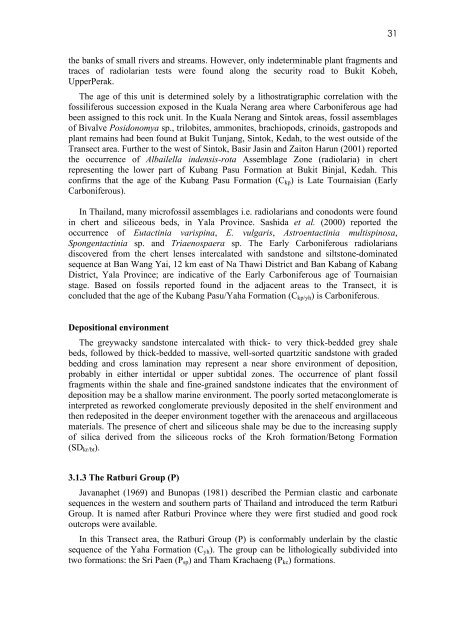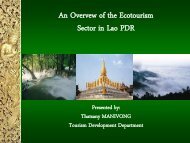GEOLOGY OF THE PENGKALAN HULU-BETONG TRANSECT ...
GEOLOGY OF THE PENGKALAN HULU-BETONG TRANSECT ...
GEOLOGY OF THE PENGKALAN HULU-BETONG TRANSECT ...
You also want an ePaper? Increase the reach of your titles
YUMPU automatically turns print PDFs into web optimized ePapers that Google loves.
the banks of small rivers and streams. However, only indeterminable plant fragments and<br />
traces of radiolarian tests were found along the security road to Bukit Kobeh,<br />
UpperPerak.<br />
The age of this unit is determined solely by a lithostratigraphic correlation with the<br />
fossiliferous succession exposed in the Kuala Nerang area where Carboniferous age had<br />
been assigned to this rock unit. In the Kuala Nerang and Sintok areas, fossil assemblages<br />
of Bivalve Posidonomya sp., trilobites, ammonites, brachiopods, crinoids, gastropods and<br />
plant remains had been found at Bukit Tunjang, Sintok, Kedah, to the west outside of the<br />
Transect area. Further to the west of Sintok, Basir Jasin and Zaiton Harun (2001) reported<br />
the occurrence of Albailella indensis-rota Assemblage Zone (radiolaria) in chert<br />
representing the lower part of Kubang Pasu Formation at Bukit Binjal, Kedah. This<br />
confirms that the age of the Kubang Pasu Formation (Ckp) is Late Tournaisian (Early<br />
Carboniferous).<br />
In Thailand, many microfossil assemblages i.e. radiolarians and conodonts were found<br />
in chert and siliceous beds, in Yala Province. Sashida et al. (2000) reported the<br />
occurrence of Eutactinia varispina, E. vulgaris, Astroentactinia multispinosa,<br />
Spongentactinia sp. and Triaenospaera sp. The Early Carboniferous radiolarians<br />
discovered from the chert lenses intercalated with sandstone and siltstone-dominated<br />
sequence at Ban Wang Yai, 12 km east of Na Thawi District and Ban Kabang of Kabang<br />
District, Yala Province; are indicative of the Early Carboniferous age of Tournaisian<br />
stage. Based on fossils reported found in the adjacent areas to the Transect, it is<br />
concluded that the age of the Kubang Pasu/Yaha Formation (Ckp/yh) is Carboniferous.<br />
Depositional environment<br />
The greywacky sandstone intercalated with thick- to very thick-bedded grey shale<br />
beds, followed by thick-bedded to massive, well-sorted quartzitic sandstone with graded<br />
bedding and cross lamination may represent a near shore environment of deposition,<br />
probably in either intertidal or upper subtidal zones. The occurrence of plant fossil<br />
fragments within the shale and fine-grained sandstone indicates that the environment of<br />
deposition may be a shallow marine environment. The poorly sorted metaconglomerate is<br />
interpreted as reworked conglomerate previously deposited in the shelf environment and<br />
then redeposited in the deeper environment together with the arenaceous and argillaceous<br />
materials. The presence of chert and siliceous shale may be due to the increasing supply<br />
of silica derived from the siliceous rocks of the Kroh formation/Betong Formation<br />
(SDkr/bt).<br />
3.1.3 The Ratburi Group (P)<br />
Javanaphet (1969) and Bunopas (1981) described the Permian clastic and carbonate<br />
sequences in the western and southern parts of Thailand and introduced the term Ratburi<br />
Group. It is named after Ratburi Province where they were first studied and good rock<br />
outcrops were available.<br />
In this Transect area, the Ratburi Group (P) is conformably underlain by the clastic<br />
sequence of the Yaha Formation (Cyh). The group can be lithologically subdivided into<br />
two formations: the Sri Paen (Psp) and Tham Krachaeng (Pkc) formations.<br />
31



